小学英语语法:助动词do 的用法
- 格式:docx
- 大小:37.34 KB
- 文档页数:2
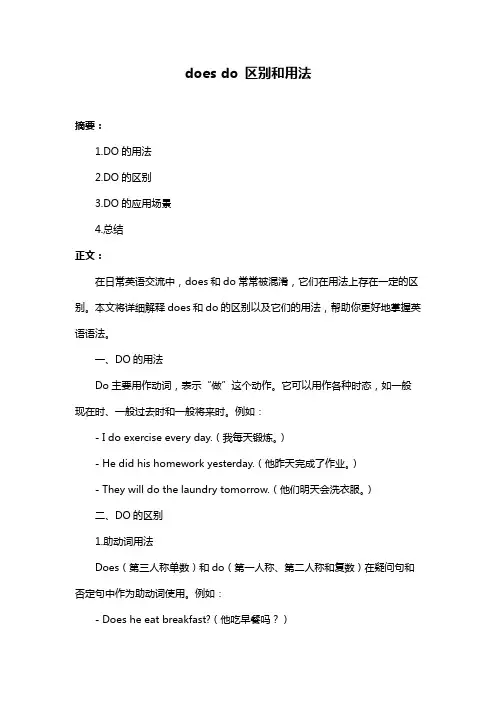
does do 区别和用法摘要:1.DO的用法2.DO的区别3.DO的应用场景4.总结正文:在日常英语交流中,does和do常常被混淆,它们在用法上存在一定的区别。
本文将详细解释does和do的区别以及它们的用法,帮助你更好地掌握英语语法。
一、DO的用法Do主要用作动词,表示“做”这个动作。
它可以用作各种时态,如一般现在时、一般过去时和一般将来时。
例如:- I do exercise every day.(我每天锻炼。
)- He did his homework yesterday.(他昨天完成了作业。
)- They will do the laundry tomorrow.(他们明天会洗衣服。
)二、DO的区别1.助动词用法Does(第三人称单数)和do(第一人称、第二人称和复数)在疑问句和否定句中作为助动词使用。
例如:- Does he eat breakfast?(他吃早餐吗?)- She doesn"t do exercise.(她不锻炼。
)2.替代动词Does可以用作替代动词,表示某个动作的发生。
例如:- She doesn"t smoke, does she?(她不抽烟,对吗?)三、DO的应用场景1.一般疑问句:Does用于询问某人是否做过某事,或者询问某事是否发生。
- Does she like coffee?(她喜欢喝咖啡吗?)2.否定回答:Do的否定回答要用no,does的否定回答要用don"t。
- Do you speak French? - No, I don"t.(你会说法语吗?- 不,我不会。
)3.肯定回答:Do的肯定回答要用yes,does的肯定回答要用does。
- Does she play the piano? - Yes, she does.(她会弹钢琴吗?- 是的,她会。
)四、总结does和do在英语中都有“做”的意思,但它们在用法上存在一定的区别。
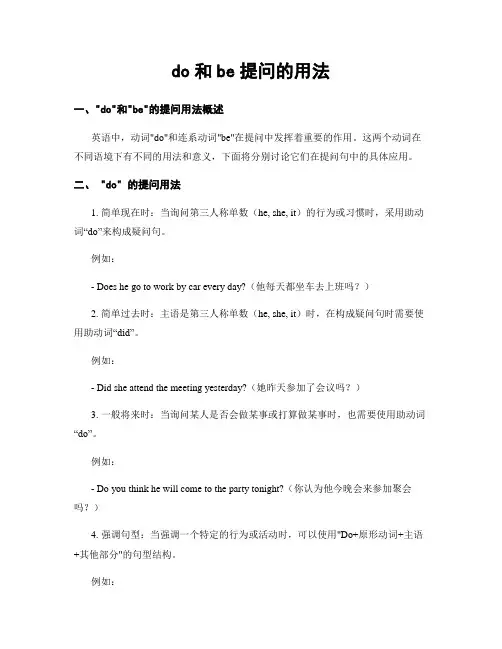
do和be提问的用法一、"do"和"be"的提问用法概述英语中,动词"do"和连系动词"be"在提问中发挥着重要的作用。
这两个动词在不同语境下有不同的用法和意义,下面将分别讨论它们在提问句中的具体应用。
二、 "do" 的提问用法1. 简单现在时:当询问第三人称单数(he, she, it)的行为或习惯时,采用助动词“do”来构成疑问句。
例如:- Does he go to work by car every day?(他每天都坐车去上班吗?)2. 简单过去时:主语是第三人称单数(he, she, it)时,在构成疑问句时需要使用助动词“did”。
例如:- Did she attend the meeting yesterday?(她昨天参加了会议吗?)3. 一般将来时:当询问某人是否会做某事或打算做某事时,也需要使用助动词“do”。
例如:- Do you think he will come to the party tonight?(你认为他今晚会来参加聚会吗?)4. 强调句型:当强调一个特定的行为或活动时,可以使用"Do+原形动词+主语+其他部分"的句型结构。
例如:- What does John do every morning before work?(约翰在上班前每天做什么?)5. 特殊疑问词+do:在特殊疑问句中,特殊疑问词(如what, where, when, why, how等)与助动词“do”连用,用来询问具体内容或细节。
例如:- What did you do last weekend?(上周末你做了什么?)三、"be" 的提问用法1. 简单现在时:在一般情况下,直接将系动词“am, is, are”放置于主语之前即可构成一般疑问句。
例如:- Are you a student?(你是学生吗?)2. 现在进行时:构成虚拟疑问句时,将系动词"is/are"移至虚拟助动词之前。
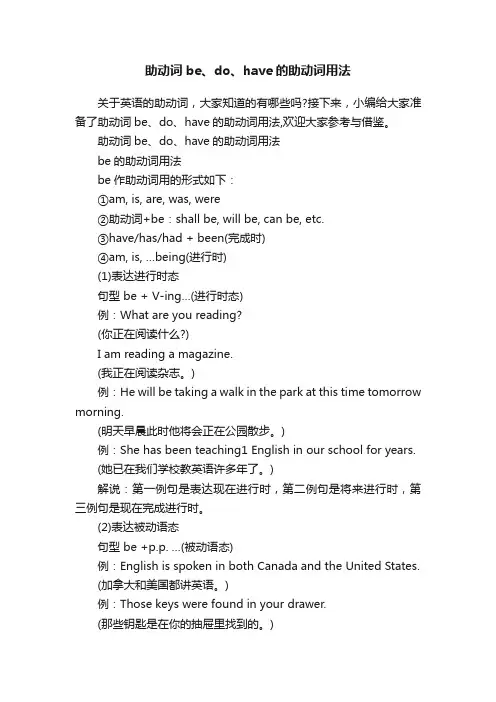
助动词be、do、have的助动词用法关于英语的助动词,大家知道的有哪些吗?接下来,小编给大家准备了助动词be、do、have的助动词用法,欢迎大家参考与借鉴。
助动词be、do、have的助动词用法be的助动词用法be作助动词用的形式如下:①am, is, are, was, were②助动词+be:shall be, will be, can be, etc.③have/has/had + been(完成时)④am, is, …being(进行时)(1)表达进行时态句型 be + V-ing…(进行时态)例:What are you reading?(你正在阅读什么?)I am reading a magazine.(我正在阅读杂志。
)例:He will be taking a walk in the park at this time tomorrow morning.(明天早晨此时他将会正在公园散步。
)例:She has been teaching1 English in our school for years.(她已在我们学校教英语许多年了。
)解说:第一例句是表达现在进行时,第二例句是将来进行时,第三例句是现在完成进行时。
(2)表达被动语态句型be +p.p. …(被动语态)例:English is spoken in both Canada and the United States.(加拿大和美国都讲英语。
)例:Those keys were found in your drawer.(那些钥匙是在你的抽屉里找到的。
)例:It can be done much faster in this way.(这件工作用这个方法可以更加快速地做好。
)have的助动词用法(1)表达完成时态句型have (has, had1) +p.p. …句型can (could2), …have + p.p.例:He can’t have said3 such4 a foolish5 word.(他不像是会说了这样傻的话。
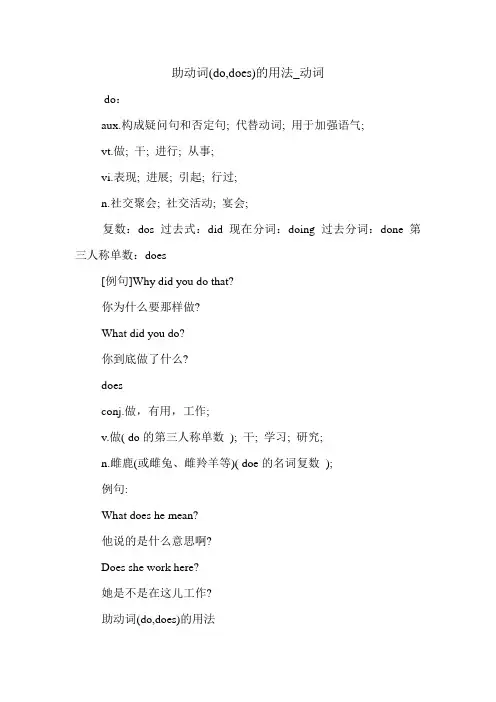
助动词(do,does)的用法_动词
do:
aux.构成疑问句和否定句; 代替动词; 用于加强语气;
vt.做; 干; 进行; 从事;
vi.表现; 进展; 引起; 行过;
n.社交聚会; 社交活动; 宴会;
复数:dos 过去式:did 现在分词:doing 过去分词:done 第三人称单数:does
[例句]Why did you do that?
你为什么要那样做?
What did you do?
你到底做了什么?
does
conj.做,有用,工作;
v.做( do的第三人称单数); 干; 学习; 研究;
n.雌鹿(或雌兔、雌羚羊等)( doe的名词复数);
例句:
What does he mean?
他说的是什么意思啊?
Does she work here?
她是不是在这儿工作?
助动词(do,does)的用法
1)当句子为肯定句时不涉及使用助动词,只涉及主谓一致原则。
2)当句子为否定句时,要根据主语的人称来决定使用相应的助动词:当主语为三单时,要使用does;当主语为非三单时,用助动词原形do。
3)当句子变疑问句时,同样要根据句子的主语来决定在句首使用Do或Does.
一般现在时用do和does,比如always,usually,often、every day(year)
第一人称、第二人称和名词复数用do(I、you、we、they、cats、dogs、~s等)
第三人称和名词单数用does(he、she、it、cat、dog等)
例句:
I do the homework.
He does the homework.
do主语第一人称does主语第三人称。
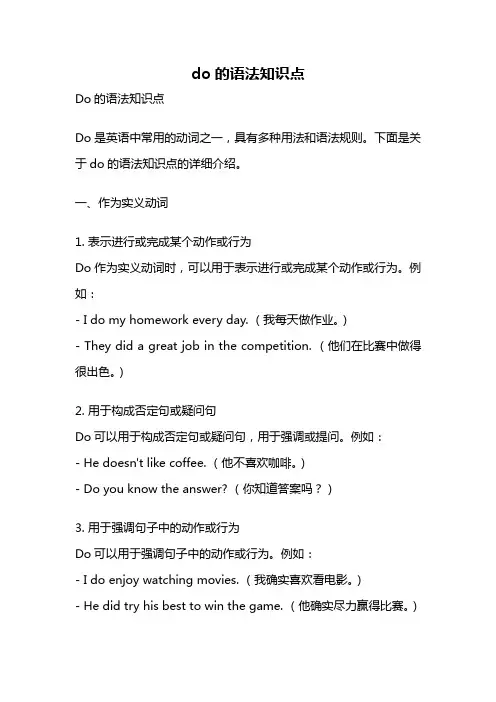
do的语法知识点Do的语法知识点Do是英语中常用的动词之一,具有多种用法和语法规则。
下面是关于do的语法知识点的详细介绍。
一、作为实义动词1. 表示进行或完成某个动作或行为Do作为实义动词时,可以用于表示进行或完成某个动作或行为。
例如:- I do my homework every day. (我每天做作业。
)- They did a great job in the competition. (他们在比赛中做得很出色。
)2. 用于构成否定句或疑问句Do可以用于构成否定句或疑问句,用于强调或提问。
例如:- He doesn't like coffee. (他不喜欢咖啡。
)- Do you know the answer? (你知道答案吗?)3. 用于强调句子中的动作或行为Do可以用于强调句子中的动作或行为。
例如:- I do enjoy watching movies. (我确实喜欢看电影。
)- He did try his best to win the game. (他确实尽力赢得比赛。
)二、作为助动词1. 用于构成肯定句Do作为助动词时,用于构成肯定句。
例如:- I do like swimming. (我确实喜欢游泳。
)- They do have a car. (他们确实有一辆车。
)2. 用于构成否定句Do作为助动词时,用于构成否定句。
例如:- I don't like spicy food. (我不喜欢辣食。
)- She doesn't live here anymore. (她不再住在这里了。
)3. 用于构成疑问句Do作为助动词时,用于构成疑问句。
例如:- Do you like chocolate? (你喜欢巧克力吗?)- Does he speak French? (他会说法语吗?)三、作为替代动词1. 用于代替前面提到的动作或行为Do可以用作替代动词,代替前面提到的动作或行为。
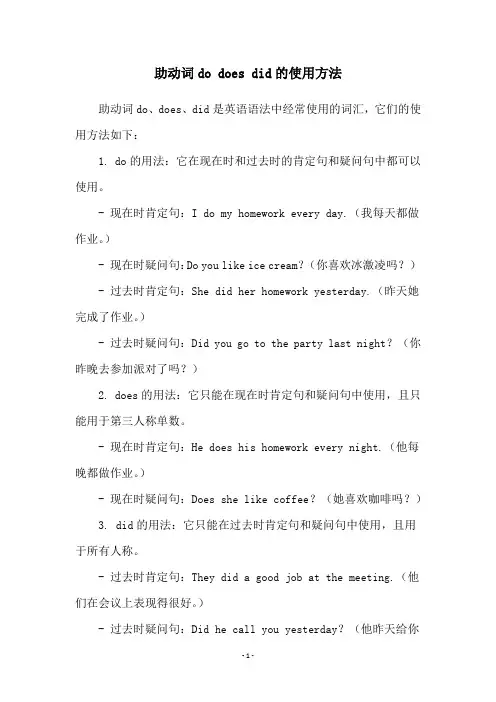
助动词do does did的使用方法助动词do、does、did是英语语法中经常使用的词汇,它们的使用方法如下:1. do的用法:它在现在时和过去时的肯定句和疑问句中都可以使用。
- 现在时肯定句:I do my homework every day.(我每天都做作业。
)- 现在时疑问句:Do you like ice cream?(你喜欢冰激凌吗?) - 过去时肯定句:She did her homework yesterday.(昨天她完成了作业。
)- 过去时疑问句:Did you go to the party last night?(你昨晚去参加派对了吗?)2. does的用法:它只能在现在时肯定句和疑问句中使用,且只能用于第三人称单数。
- 现在时肯定句:He does his homework every night.(他每晚都做作业。
)- 现在时疑问句:Does she like coffee?(她喜欢咖啡吗?) 3. did的用法:它只能在过去时肯定句和疑问句中使用,且用于所有人称。
- 过去时肯定句:They did a good job at the meeting.(他们在会议上表现得很好。
)- 过去时疑问句:Did he call you yesterday?(他昨天给你打电话了吗?)在句子中,do、does、did的位置通常在主语之前,而主语后面的动词则使用原形。
例如:- I do my homework every day.(我每天都做作业。
)- Does she like coffee?(她喜欢咖啡吗?)- Did you go to the party last night?(你昨晚去参加派对了吗?)总之,助动词do、does、did的正确使用对于英语语法的正确掌握至关重要,需要认真学习和练习。
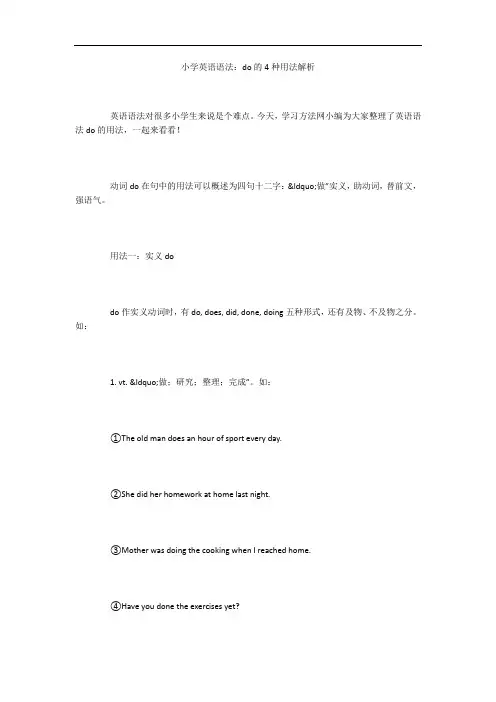
小学英语语法:do的4种用法解析英语语法对很多小学生来说是个难点。
今天,学习方法网小编为大家整理了英语语法do的用法,一起来看看!动词do在句中的用法可以概述为四句十二字:“做”实义,助动词,替前文,强语气。
用法一:实义dodo作实义动词时,有do, does, did, done, doing五种形式,还有及物、不及物之分。
如:1. vt. “做;研究;整理;完成”。
如:①The old man does an hour of sport every day.②She did her homework at home last night.③Mother was doing the cooking when I reached home.④Have you done the exercises yet?2. vi. “行动;工作;进展;足够”。
如:①Kate does very well in her Chinese.②How do you do?③Well done!④That will do.用法二:助动dodo作助动词时,只有do, does, did三种形式,无词义,限用于含行为动词的一般现在时和一般过去时两种时态的否定句和疑问句中。
如:①They don't have any tickets for tonight's concert.②Kate stayed at home last night, didn't she?③How many books does the library have?④She doesn't do the washing in the evening.用法三:替代do为避免动词的重复,使语言简练,常以do, does, did替代前文所用的行为动词。
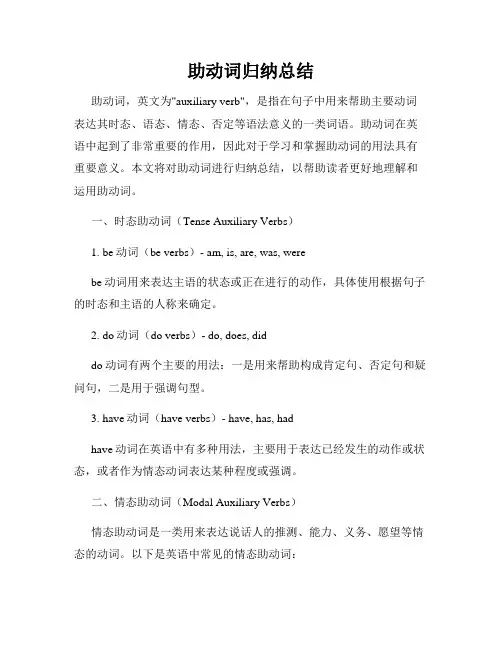
助动词归纳总结助动词,英文为"auxiliary verb",是指在句子中用来帮助主要动词表达其时态、语态、情态、否定等语法意义的一类词语。
助动词在英语中起到了非常重要的作用,因此对于学习和掌握助动词的用法具有重要意义。
本文将对助动词进行归纳总结,以帮助读者更好地理解和运用助动词。
一、时态助动词(Tense Auxiliary Verbs)1. be动词(be verbs)- am, is, are, was, werebe动词用来表达主语的状态或正在进行的动作,具体使用根据句子的时态和主语的人称来确定。
2. do动词(do verbs)- do, does, diddo动词有两个主要的用法:一是用来帮助构成肯定句、否定句和疑问句,二是用于强调句型。
3. have动词(have verbs)- have, has, hadhave动词在英语中有多种用法,主要用于表达已经发生的动作或状态,或者作为情态动词表达某种程度或强调。
二、情态助动词(Modal Auxiliary Verbs)情态助动词是一类用来表达说话人的推测、能力、义务、愿望等情态的动词。
以下是英语中常见的情态助动词:1. can - can用于表达能力、许可、请求等意义,表示某种能力或者许可的可能性。
2. could - could表示过去某个时间或某种情况下的能力、权力或能够实现某种愿望。
3. may - may表示允许、可能性、推测等。
4. might - might用于表示推测、假设、婉约等。
5. must - must表示必要性、肯定性、推断等,用于表达说话人的主观判断或推测。
6. shall - shall一般用于第一人称中,表示征求建议、提议、命令等。
7. should - should用于表示某种义务、推测、建议等。
8. will - will表示未来、意愿、承诺等。
9. would - would表示过去的习惯、假设等。
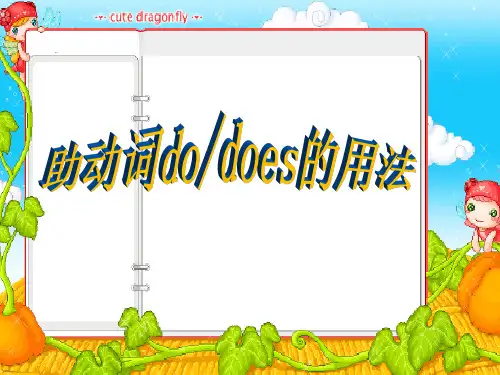
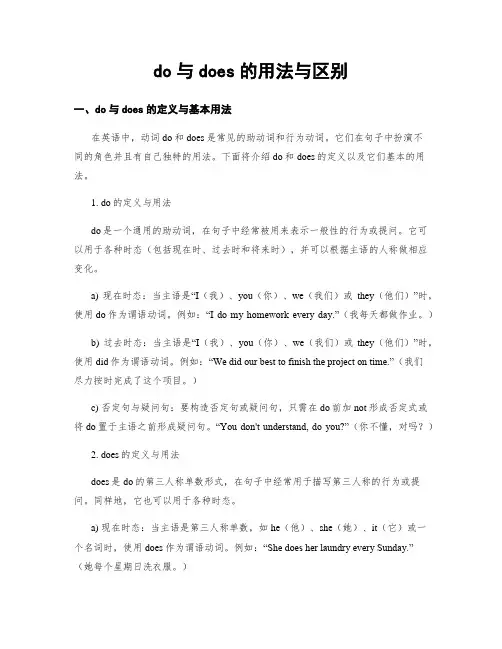
do与does的用法与区别一、do与does的定义与基本用法在英语中,动词do和does是常见的助动词和行为动词。
它们在句子中扮演不同的角色并且有自己独特的用法。
下面将介绍do和does的定义以及它们基本的用法。
1. do的定义与用法do是一个通用的助动词,在句子中经常被用来表示一般性的行为或提问。
它可以用于各种时态(包括现在时、过去时和将来时),并可以根据主语的人称做相应变化。
a) 现在时态:当主语是“I(我)、you(你)、we(我们)或they(他们)”时,使用do作为谓语动词。
例如:“I do my homework every day.”(我每天都做作业。
)b) 过去时态:当主语是“I(我)、you(你)、we(我们)或they(他们)”时,使用did作为谓语动词。
例如:“We did our best to finish the project on time.”(我们尽力按时完成了这个项目。
)c) 否定句与疑问句:要构造否定句或疑问句,只需在do前加not形成否定式或将do置于主语之前形成疑问句。
“You don't understand, do you?”(你不懂,对吗?)2. does的定义与用法does是do的第三人称单数形式,在句子中经常用于描写第三人称的行为或提问。
同样地,它也可以用于各种时态。
a) 现在时态:当主语是第三人称单数,如he(他)、she(她)、it(它)或一个名词时,使用does作为谓语动词。
例如:“She does her laundry every Sunday.”(她每个星期日洗衣服。
)b) 否定句与疑问句:构造否定句或疑问句的方法与do相同。
“Does he not like coffee?”(他不喜欢咖啡吗?)二、do与does的区别尽管do和does在一些方面有着相似之处,但它们也存在一些重要的区别点。
1. 主语的不同do用于所有人称(I、you、we、they),而does仅限于第三人称单数形式(he、she、it)和名词。
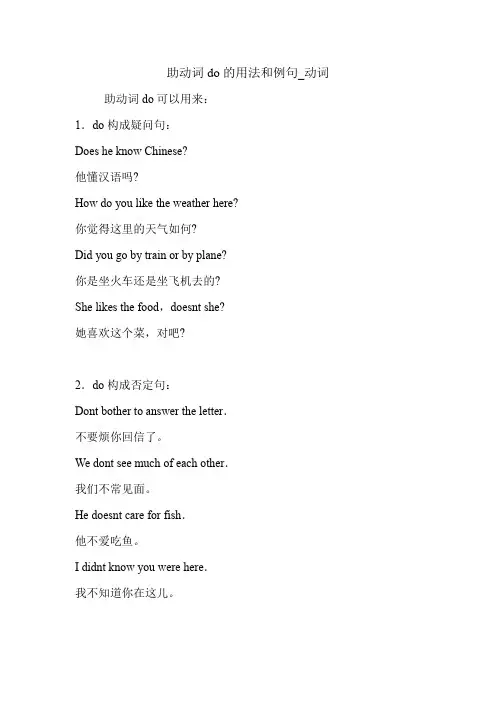
助动词do的用法和例句_动词助动词do可以用来:1.do构成疑问句:Does he know Chinese?他懂汉语吗?How do you like the weather here?你觉得这里的天气如何?Did you go by train or by plane?你是坐火车还是坐飞机去的?She likes the food,doesnt she?她喜欢这个菜,对吧?2.do构成否定句:Dont bother to answer the letter.不要烦你回信了。
We dont see much of each other.我们不常见面。
He doesnt care for fish.他不爱吃鱼。
I didnt know you were here.我不知道你在这儿。
3.表示前面所说动作,以避免重复:Do you work together?Yes.we do.你们在一起工作吗?足的。
(我们在一起工作。
)You dont want to be late.Neither does she.你不想迟到,她也不想迟到。
Youre doing better than you did last term你这学期比上学期表现好。
I said he would fail,and he did.我说他会失败,他真的失败了。
加强语气(起强调作用):I do think youre right.我确实认为你是对的。
She does feel that way.她确实有这种感觉。
She did say that.她确实这样说的。
Do be careful.千万小心。
do在更多情况下用作实意动词,用法很灵活,可表示许多意思,如:Martin has done an excellent article.马丁写了一篇精彩的文章。
He has done a portrait of Lilly.他画了一张丽丽的画像。
助动词do和be的用法在英语学习中,助动词 do 和 be 是非常重要的部分,它们在句子中有着不同的用法和功能。
理解并正确运用这两个助动词,对于准确表达意思、构建正确的句子结构至关重要。
首先,我们来看看助动词 do 。
Do 主要有三种形式:do 、does 、did 。
Do 用于一般现在时中主语是第一人称(I)、第二人称(you)以及复数(we 、they 、the boys 等)的情况。
例如:“I do my homework every day”(我每天做作业。
)“They do sports in the morning”(他们早上做运动。
)Does 则用于一般现在时中主语是第三人称单数(he 、she 、it 、Tom 等)的情况。
比如:“She does well in English”(她英语学得好。
)“It does not rain often here”(这里不常下雨。
)Did 用于一般过去时,无论主语是什么人称和数。
“We did our best yesterday”(昨天我们尽了最大努力。
)“He did not come to the party”(他没来参加聚会。
)Do 和 does 在句子中的主要作用是构成疑问句和否定句。
在构成疑问句时,将 do 或 does 放在主语前。
比如,“Do you like music?”(你喜欢音乐吗?)“Does he play football?”(他踢足球吗?)如果句子中有实义动词,在否定句中要在实义动词前加 don't 或 doesn't 。
例如,“I don't watch TV at night”(我晚上不看电视。
)“She doesn't have lunch at school”(她不在学校吃午饭。
)接下来,我们说说助动词 be 。
Be 有 am 、is 、are 、was 、were 这几种形式。
英语中助动词do的用法在英语学习的过程中,助动词 do 是一个非常重要且常用的词。
它有着多种用法,掌握好 do 的用法对于准确表达和理解英语句子的意思至关重要。
首先,do 用于一般现在时的否定句和疑问句中。
当我们要把一个一般现在时的陈述句变成否定句时,如果句子中的谓语动词是实义动词,且主语是第一人称、第二人称、第三人称复数时,就需要借助助动词do 加上 not 来构成否定形式。
比如,“I like apples”这个句子要变成否定句,就是“I don't like apples” 再比如,“They play football every day”变成否定句就是“They don't play football every day”在一般现在时的疑问句中,如果句子中的谓语动词是实义动词,且主语是第一人称、第二人称、第三人称复数时,也要用助动词 do 来提问。
例如,“You do your homework at night”变成疑问句就是“Do you do your homework at night?” 还有,“We have breakfast at seven”变为疑问句就是“Do we have breakfast at seven?”其次,do 用于强调句中。
为了强调某个动作,我们可以使用助动词do,这时 do 要重读,且其后的动词要用原形。
比如,“I do love you”这句话中,通过“do”强调了“love”这个动作,表示“我确实爱你”。
再比如,“He does work hard”意思是“他确实工作努力”。
然后,do 还用于替代前面出现过的动词短语,以避免重复。
例如,“I don't like coffee But my sister does”这里的“does”就替代了“likes coffee”。
此外,助动词 do 还用于祈使句的否定形式中。
例如,“Don't do that”(不要那样做。
标题:深入探讨“do, does, did” 用法及口诀在我们的日常英语学习中,助动词“do, does, did” 是不可或缺的一部分。
它们在句子中扮演着重要的角色,常常用来构成肯定句、否定句、疑问句以及简化回答。
而且,它们的用法有时会让学习者感到困惑。
在本文中,我们将全面探讨“do, does, did”的用法,以便更好地掌握它们。
一、基本用法:1. “Do” 用于主语为第一人称单数(I)、第二人称(you)、第一人称复数(we)、第二人称复数(you)以及第三人称复数(they)的句子中。
2. “Does” 用于主语为第三人称单数(he, she, it)的句子中。
3. “Did” 用于过去式句子中。
二、否定句和疑问句的构成:1. 否定句:在肯定句后面加上“not”,构成否定句。
2. 疑问句:将助动词移到句子的最前面。
三、口诀:在学习“do, does, did”的用法时,我们可以依靠一些简单的口诀来帮助记忆。
比如:“Do对I, you, we, they; Does对he, she, it; Did是过去式,要记牢,否定句加not,疑问句倒装。
”四、个人观点和理解:通过深入学习和思考“do, does, did” 的用法,我认识到这些助动词在句子中的重要性。
通过口诀的记忆方法,我更加轻松地掌握了它们的用法。
在实际运用中,我也更加准确地使用这些助动词,使我的英语表达更加得当。
在本文中,我们对“do, does, did”的用法进行了全面而深入的探讨。
通过对基本用法、否定句和疑问句构成以及口诀的介绍,相信读者已经对这一主题有了更加全面、深刻的理解。
通过不断地练习和应用,相信大家都能够更加熟练地运用“do, does, did”,提升自己的英语水平。
“do, does, did” 是英语语法中非常重要的一部分,掌握它们的用法对于提高英语水平至关重要。
在这篇文章中,我们深入探讨了它们的基本用法以及否定句、疑问句的构成,并且提出了口诀来帮助记忆。
do在句子中的用法Do是英语中常用的词汇之一,它的用法多种多样,可以是动词、助动词、情态动词等。
在本篇文章中,我们将重点讨论do在句子中的用法,帮助大家更好地理解和运用这个词汇。
一、do作动词作为动词,do通常表示“做、干、执行”等意思。
它可以单独使用,也可以和其他词汇组成动词短语。
1. 单独使用Do可以单独使用,表示“做、干、执行”等意思。
例如:What do you do? 你做什么工作?I do my homework every day. 我每天都做作业。
2. 与其他词汇组成动词短语Do还可以和其他词汇组成动词短语,表示更加具体的含义。
例如:Do the dishes 洗碗Do the laundry 洗衣服Do the shopping 买东西Do your hair 梳头发Do your nails 指甲护理二、do作助动词作为助动词,do通常用于构成疑问句、否定句等句型中。
它的作用是强调动词的意义,使语气更加强烈。
1. 构成疑问句Do可以和主语一起构成疑问句,用来询问对方的情况、意见等。
例如:Do you like coffee? 你喜欢咖啡吗?Do you speak English? 你会说英语吗?2. 构成否定句Do还可以和not构成否定句,用来表示否定的意思。
例如:I do not like spicy food. 我不喜欢辣的食物。
He does not have a car. 他没有车。
三、do作情态动词作为情态动词,do通常用于强调语气,表示强烈的意愿、命令、建议等。
在这种情况下,它通常不需要加动词的原形。
1. 表示强烈的意愿Do可以用于表示强烈的意愿,表达说话人的决心和坚定。
例如: I do want to go to the party. 我真的想去参加这个聚会。
I do love you. 我真的爱你。
2. 表示命令Do还可以用于表示命令,表达说话人的权威和决心。
在疑问句中do的用法疑问句是英语中常见的一种语法形式,用于提出问题或表达疑惑。
在构成疑问句时,我们通常会使用助动词do来辅助疑问句的谓语动词形式。
本文将介绍do在构成疑问句中的不同用法,并对其使用进行详细解释。
一、do构成一般疑问句在肯定式的基础上构成一般疑问句时,我们需要使用助动词do。
这种结构通常用于询问事实或真实情况。
例如:1. He plays basketball.(他打篮球。
)→ Does he play basketball?(他打篮球吗?)2. She likes ice cream.(她喜欢冰淇淋。
)→ Does she like ice cream?(她喜欢冰淇淋吗?)3. They live in London.(他们住在伦敦。
)→ Do they live in London?(他们住在伦敦吗?)通过在陈述句中加入助动词do并倒装主语和助动词的位置,我们可以快速构成简单而直接的一般疑问句。
二、do在否定句中除了用于构成一般疑问句外,助动词do还可以用于否定句中。
在构成否定句时,我们需要在助动词do后面添加not。
例如:1. He doesn't play basketball.(他不打篮球。
)2. She doesn't like ice cream.(她不喜欢冰淇淋。
)3. They don't live in London.(他们不住在伦敦。
)通过将助动词do和not组合在一起,我们可以简单明了地表达否定的意思。
三、do的强调用法除了构成疑问句和否定句外,助动词do还可用于强调特定内容。
这种用法常见于回答或解释他人的疑问。
例如:A: Do you speak Spanish?(你会说西班牙语吗?)B: I do speak Spanish.(我确实会说西班牙语。
)A: Did they finish the project on time?(他们按时完成了项目吗?)B: They did finish the project on time.(他们确实按时完成了项目。
问句中do和is的用法区别一、do和is的基本含义和用法在英语中,动词是非常重要的一部分。
在问句中,我们经常使用“do”和“is”作为助动词或系动词。
但是,这两个词的用法和含义有着明显的区别。
本文将详细解释并比较问句中“do”和“is”的用法。
1. “Do”的含义和用法“Do”是一个常见的助动词,表示一种动作、行为或事情的进行。
它可以用于询问关于特定活动、习惯、喜好等的问题。
当对某个主语进行提问时,“do”必须与主语保持一致,即在第三人称单数形式(he/she/it)时需要加上“does”。
例如:- What do you do for a living?(你做什么工作谋生?)- Does he play tennis on weekends?(他周末打网球吗?)此外,“do”也可以与特定动词结合形成不同的短语。
例如:- Do you want to go out for dinner tonight?(你今晚想出去吃晚餐吗?)- I don't know what to do.(我不知道该做什么。
)- Did you do your homework?(你完成家庭作业了吗?)2. “Is”的含义和用法“Is”是一个常见的系动词,用于表达状态或性质。
它通常用于询问、描述或表达对某人或某物的判断。
例如:- Is she your sister?(她是你的妹妹吗?)- He is a doctor.(他是一名医生。
)“Is”还可以与形容词连用,表示特定的状态。
例如:- The weather is nice today.(今天天气很好。
)- The book is interesting.(这本书很有趣。
)二、do和is在问句中的区别1. 功能不同“Do”通常用作助动词,用于提问关于活动、行为等方面的问题,以获得更多信息。
而“is”则是系动词,用于询问事物的状态、性质等,并描述主语。
2. 语法形式不同“Do”根据主语的人称和数进行变化,如第三人称单数要加上“does”。
小学英语语法:助动词do 的用法
1) 构成一般疑问句,例如:
Do you want to pass the CET? 你想通过大学英语测试吗?
Did you study German? 你们学过德语吗?
2) do + not 构成否定句,例如:
I do not want to be criticized. 我不想挨批评。
He doesn't like to study. 他不想学习。
In the past, many students did not know the importance of English. 过去,好多学生不知道英语的重要性。
3) 构成否定祈使句,例如:
Don't go there. 不要去那里。
Don't be so absent-minded. 不要这么心不在焉。
说明:构成否定祈使句只用do,不用did和does。
4) 放在动词原形前,增强该动词的语气,例如:
Do come to my birthday party. 一定来参加我的生日宴会。
I did go there. 我确实去那儿了。
I do miss you. 我确实想你。
5) 用于倒装句,例如:
Never did I hear of such a thing. 我从未听说过这样的事情。
Only when we begin our college life do we realize the importance of English.
只有在开始大学生活时我们才理解到英语的重要性。
说明:引导此类倒装句的副词有never, seldom, rarely, little, only, so, well等。
6) 用作代动词,例如:
---- Do you like Beijing? --你喜欢北京吗?
---- Yes, I do. --是的,喜欢。
(do用作代动词,代替like Beijing.)
He knows how to drive a car, doesn't he?
他知道如何开车,对吧?
助动词do 的用法是我们精心为大家准备的,希望大家能够多加练习,为以后学好英语打下坚实的基础!。